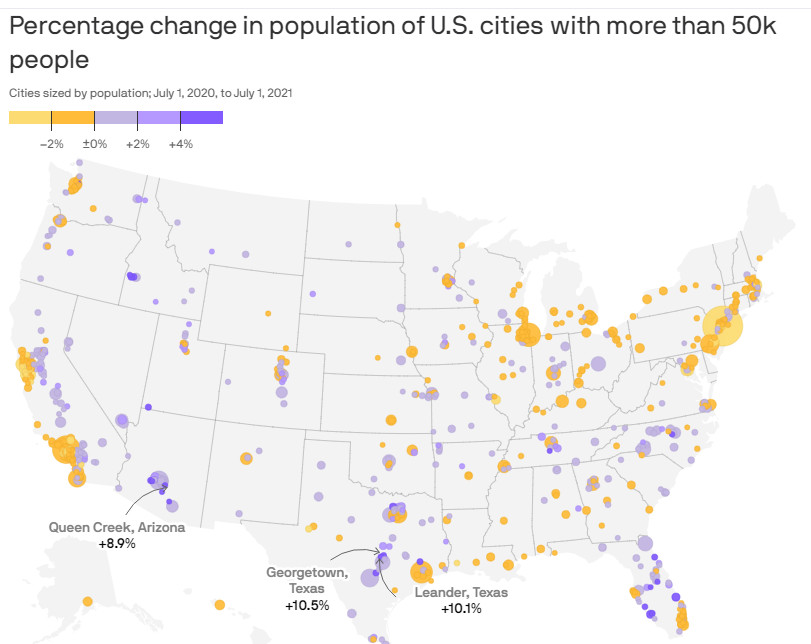
OVERVIEW
MANAGEMENT
PERFORMANCE
POSSIBILITIES
CAPITALS
ACTIVITIES
ACTORS
BURGESS
|
US POPULATION
SIGNIFICANT RECENT INTERNAL MIGRATIONS Where America's cities are growing ... Percentage change in population of U.S. cities with more than 50k people 
Data: Census Bureau. Map: Baidi Wang/Axios Original article: https://www.axios.com/2022/05/30/us-population-growth-arizona-texas-florida Peter Burgess COMMENTARY Peter Burgess | ||
|
Where America's cities are growing
Percentage change in population of U.S. cities with more than 50k people Mike Allen, author of Axios AM May 30th 2022 America's top 15 cities by percentage growth last year were clustered in Arizona, Texas and Florida, with a few in Idaho and one in Tennessee. Why it matters: The U.S. is spreading out, heading South and West and creating new boomtowns, tech hubs and rising power centers. A Census Bureau release last week showed Georgetown, Texas, had the most growth from July 2020 to July 2021 — 10.5%, a rate that would double the population in less than seven years. Next were Leander, Texas (10.1%) ... Queen Creek Town, Ariz. (8.9%) ... Buckeye, Ariz. (8.6%) ... and New Braunfels, Texas (8.3%). The sixth-fastest-growing area was Fort Myers, Fla. (6.8%). Then Casa Grande, Ariz. (6.2%) ... Maricopa, Ariz. (6.1%) ... North Port, Fla. (5.5%) ... Spring Hill, Tenn. (5.4%) ... Goodyear, Ariz. (5.4%) ... and Port St. Lucie, Fla. (5.2%). Three suburbs of Boise, Idaho were in spots 13-15: Meridian (5.2%) ... Caldwell (5.2%) ... and Nampa (5.0%). 
San Antonio topped the list of largest numeric gainers (graphic above). ---------------- Go deeper: See what happened in the 10 biggest cities. Big cities saw population declines during pandemic Ivana Saric May 26, 2022 - Politics & Policy 
Data: U.S. Census Bureau; Note: Population is on July 1, 2021; Chart: Baidi Wang/Axios More than half of the country's 15 largest cities saw population decreases during the coronavirus pandemic, according to new U.S. census data released Thursday measuring city growth from July 2020 to July 2021. Driving the news: The switch to remote work during the pandemic enabled many people to move, prompted desires for cheaper cost of living or lifestyle changes. By the numbers: Although New York remains the nation's largest city, its population decreased by more than 305,000 people during the pandemic, about 3.5% of its population.
Between the lines: Chicago and San Francisco's populations have now dropped to close to their 2010 levels, the Wall Street Journal reported.
| The text being discussed is available at | https://www.axios.com/2022/05/30/us-population-growth-arizona-texas-florida and |